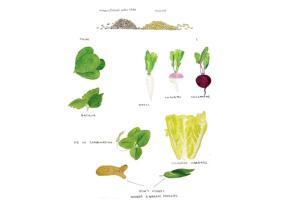A filmmaker with an interest in edible greens runs a quaint documentation project that you should check out to understand what you put in your mouth

The sat patta dal is prepared with the addition of greens. It is cooked only with mash and moong dals
Trained as a filmmaker, 32-year-old Farah Yameen's work now primarily surrounds public histories, digital archives, and food ethnographies. But, it is her knowledge in edible greens that she is recently becoming known for. "My interest in edible greens was not an epiphanous eureka moment. I was not an adventurous greens eater as child. In fact, I think I can safely say that we rotated between some 20 vegetables in our household, many of which I'd screw my face at. This, even though I grew up in Jharkhand, a place of many indigenous cuisines, and more greens than I can name. I had never eaten sarson [mustard] or goosefoot [bathua] until I came to Delhi to study at Jamia Millia Islamia," she admits. And that's surprising because she is now the name behind the fascinating Instagram project, The Saag Archive.
ADVERTISEMENT
When it launched, the page featured Yameen's drawings on new greens that she spotted in vegetable markets. "It dawned upon me belatedly [and if you think about it, this was obvious] that the way we eat greens, and the kinds we eat, reflect multiple things: agrobiodiversity, climate change, social inequality, the market economy and local food cultures. The biodiversity and climate change aspect is evident enough. A number of species and wild foods are threatened on account of monocultures and climate change. Most of us cannot recognise one weed from another, although there are new foraging movements that are attempting to change this. But while it is easy to exoticise this as traditional knowledge being preserved—which I admit is certainly an aspect—an equally important perspective is that a number of greens are eaten because no food is available. Khesari for instance, is a weed that was later cultivated for both its legumes and leaves in case drought struck. Many leaves became part of our food because people could not afford other sources of sustenance. It is also why most leaves are cooked so simply—boiled or lightly fried in fat—there were limited resources."

Farah Yameen
The project was never intended to elicit a response. It is a documentation effort that Yameen expected would remain obscure forever.
"Illustrating greens isn't something I have found easy. And one reason I have never promoted the page is because I create my stories and illustrations slowly. I have documented more than 70 greens of which only half are up on the page. I suppose I'll get there when I do. This page is a languid experiment in observing what people eat, how they eat it, and why. It shall continue to move on at this pace, through conversations and travels, and I'll keep adding," she concludes.
Lathyrus sativus

Khesari (Hindi), Grass pea (English); "This innocuous-looking grass has been much maligned on account of its grains. History lessons tell us that the storage and sale of khesari dal was banned in India in 1961 and subsequently imposed in various states across the country. In rural areas, when crops failed, khesari, grown as cover crop or for fodder, was often the only thing that survived both water logged soils and drought."
Chorchorus olitorius.

Morapaat (Assamese), Jute Mallow, West African Mallow, Indian Mallow (English), Tita paat (Bengali); According to Tariq Ali, who wrote a book on jute, "Jute emerged as a global commodity in the mid-nineteenth century, when the Crimean War (1853–56) interrupted Britain's supply of Russian flax and hemp, and manufacturers in Scotland, switched en masse to jute."
What: The Saag Archive
Where: @thesaagarchive
Keep scrolling to read more news
Catch up on all the latest Mumbai news, crime news, current affairs, and a complete guide from food to things to do and events across Mumbai. Also download the new mid-day Android and iOS apps to get latest updates.
Mid-Day is now on Telegram. Click here to join our channel (@middayinfomedialtd) and stay updated with the latest news
 Subscribe today by clicking the link and stay updated with the latest news!" Click here!
Subscribe today by clicking the link and stay updated with the latest news!" Click here!






